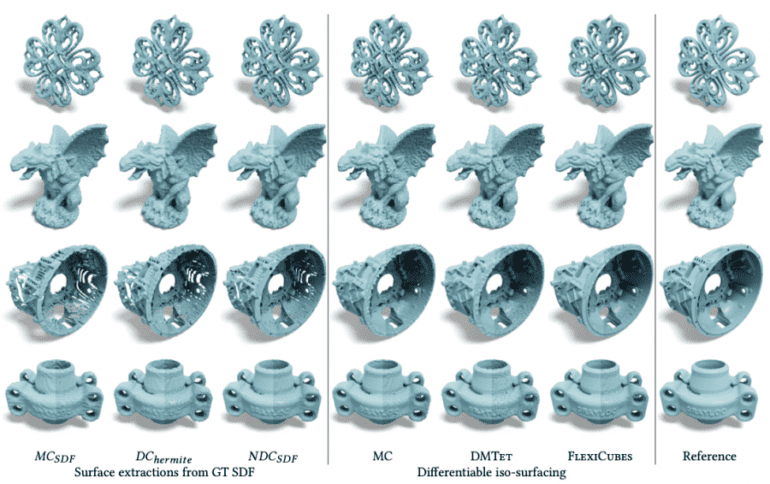TL;DR:
- NVIDIA introduces FlexiCubes, a groundbreaking approach for producing high-quality 3D meshes in AI pipelines.
- FlexiCubes enhances mesh generation through adaptable parameters, optimizing mesh quality.
- The technique seamlessly replaces marching cubes, integrating with optimization-focused AI pipelines.
- Generated meshes excel in capturing intricate details, benefiting applications from reconstructions to immersive experiences.
- FlexiCubes’ tetrahedral meshes enhance physics simulations for efficiency and robustness.
- NVIDIA’s innovation opens doors for elevated 3D mesh quality, advancing AI-driven experiences.
Main AI News:
The realm of artificial intelligence (AI) is continually reshaping the boundaries of what was once deemed possible, as demonstrated by the evolution of next-generation AI pipelines. These pipelines have achieved remarkable feats in producing intricate and lifelike 3D models. Ranging from faithfully reconstructed scenes sourced from images to AI-generated assets tailored for immersive interactive encounters, these models showcase the extent of AI’s capabilities.
Central to the success of these AI pipelines is the creation of 3D meshes, commonly represented as standard triangle configurations. The compatibility of these meshes with prevailing software platforms underscores their importance, not to mention their alignment with advanced hardware acceleration and their role in facilitating physics simulations. Yet, the true potential of these mesh representations emerges when they are executed with an unwavering commitment to exceptional quality.
Recent endeavors in research spearheaded by NVIDIA have unveiled an innovative solution known as “FlexiCubes,” revolutionizing the production of top-tier meshes within 3D pipelines. This groundbreaking development ushered in an era of heightened quality across a diverse spectrum of applications.
The Ingenuity Fueling FlexiCubes Mesh Generation
At the heart of AI pipelines, whether for reconstruction or simulation, lies a shared foundation: meshes are meticulously crafted through a nuanced optimization process. This process refines the representation iteratively, aligning it more closely with the desired outcome.
The transformative concept at the core of FlexiCubes mesh generation involves the integration of adaptable supplementary parameters. These parameters are meticulously refined throughout the optimization process, resulting in a substantial enhancement in the quality of the mesh.
For those well-versed in mesh-based pipelines, the technique of using marching cubes to extract meshes is a familiar one. Within this context, FlexiCubes seamlessly takes the place of marching cubes, integrating flawlessly with optimization-centric AI pipelines.
Elevating Mesh Excellence, Supercharging AI
The impact of FlexiCubes on the domain of 3D mesh generation is nothing short of profound. It serves as a catalyst for numerous modern mesh generation pipelines, yielding meshes of unparalleled quality that excel in faithfully capturing intricate details within complex shapes.
Moreover, these generated meshes exhibit an exceptional aptitude for physics simulations—an area where mesh quality plays a pivotal role in optimizing simulation efficiency and resilience. The tetrahedral meshes created by FlexiCubes are primed for immediate application in out-of-the-box physics simulations.
Conclusion:
NVIDIA’s innovative FlexiCubes mark a significant advancement in the 3D mesh generation landscape for AI workflows. By introducing adaptable parameters and seamlessly integrating with existing pipelines, this technology enhances mesh quality and unlocks new possibilities in applications ranging from reconstructions to immersive experiences. Moreover, the optimized tetrahedral meshes contribute to efficient and robust physics simulations. This development underscores NVIDIA’s commitment to pushing the boundaries of AI-driven experiences, promising a future of elevated quality and innovation in the market.

